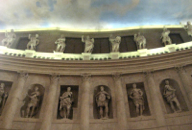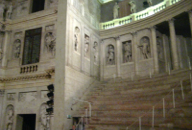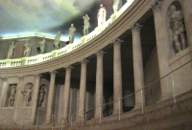TeATRO OLYMPICO
Monte Berico, Vicenza, the veneto
northern italy
Europe


TeATRO OLYMPICO
Monte Berico, Vicenza, the veneto
northern italy
Europe




There is no possible way to photograph the genius of this Palladian theater, its design inspired by the outdoor ancient Greek and Roman theaters. Palladio gave a lifetime of thought to this idea. His research included studies of the classical theater, the writings of Vitruvius’ De Architectura, and his inspection of the Roman ruins of the Theatre Berga in Vicenza. Palladio’s drawings and writings on the subject eventually lead to the building of Theatre Olympico, commissioned by the Accademia in Vicenza. His assignment was to design a theater to be built in a building adjoining the Accademia, an abandoned prison and ammunition storage warehouse. It’s construction, begun in 1579, was only six months along when Palladio died. Beginning in 1580, the progress of Palladio’s ideal theater was overseen by his son, Silla. Four years later, the cavea, loggia, and proscenium were completed. The theater is a triumph of classical architecture. Its versatility, the wide but shallow stage, and the proximity of the actors to the audience, powerfully juxtapose life and art. The sets of the theater, a triumph of Renaissance perspective, were designed by a student of Palladio’s, Vincenzo Scamozzi. He constructed seven hallways representing the city of Thebes, Greece, introducing this new idea of perspective to the theater. Seven streets, appearing endless in their depth were created in a shallow space amounting to mere meters. The opening production for the inauguration of the theater on March 3, 1585, was Sophocles’ Oedipus Rex. The original sets have never been removed, and remain today. The original lighting system, designed to emulate reality in the street scenes, was made of small oil lamps of blown glass, designed by Scamozzi. Today, the theater is used for plays for the smaller audience, staged in autumn and spring, in a theater without heat or air conditioning which helps preserve the fragile 16th century wooden sets.. Scamozzi would probably be surprised and pleased that his “temporary” stage set is still enjoyed today, 400 years later. Henry and I bought tickets, entered the theater with audio guides in hand, and carefully found a seat on the loggia side facing the proscenium. Small groups joined us, and photography was allowed. The taped explanation of the architecture, with its history and description of the first performance was riveting. It was also a special treat to see the described oil lamps in the Accademia building which served as the bookshop and the formal entrance to the theater.
PHOTOS:
The Proscenium Left Column: 1. The left backdrop of the proscenium. 2. The classical detailing over the central arch of the Proscenium. Center, Top: The central arch of the stage, with the stage set by Scamozzi in the background. Right Column: 1. Niche with sculpture representing members of the Academia in Roman costume. 2. One of the 7 streets of Thebes, Greece, a triumph of Renaissance perspective, introduced to the theater for the first time in Theatre Olympia.
The Loggia: Left Column: 3. Ceiling detail where the coffered ceiling above the proscenium meets the cavea, or audience seating, painted with sky and clouds, emulating the outdoors and nature. 4. The loggia, located behind the audience, giving the entire theater the ambience of an ancient Greek or Roman theater. Center, Bottom: Niches in the loggia filled with statues of the Academia members, each dressed in the costume of ancient Rome. Right Column: 3. View of the theater where the cavea meets the proscenium. 4. View of the loggia where the ceiling painting imitates the sky.


An Ancient Outdoor Theater ... Indoors






